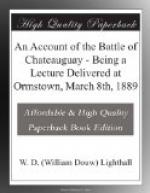Next, how ought the credit of the affair to be apportioned, for it is clear that it is due to a number concerned? De Salaberry is, of course, in every way the leading figure. His courage and spirit were perfect, his intelligence rapid, his labor incessant, and the whole choice of the field and strategy of the battle were, by all the testimony, due to him. On the whole, it almost seems, in its broad lights, like a battle of this one man against the enemy. His task was the greater from the extent and obscurity of the battlefield. On these accounts, some of those holding the positions used afterwards to say there was no battle at all, and one—Lieut. Delisle, who received a pension—that the whole thing was a farce. Frankly—and it may seem at first sight like a discourtesy to say it—it is doubtful whether the Voltigeurs would have stood much real fighting had they been opposed to veterans. On reasonable consideration this objection must disappear. It is well known that recruits away from their homes are utterly unstable in their first battles. For instance, at Bull’s Run, in the first two battles of the American Civil War, it was a toss-up which side would run away from the other, and they decided it by one side doing so the first day, and the other side the second. Many of the Upper Canadians were fearful and undecided at the beginning of the War of 1812. It is pretty probable that the promptitude of the few regulars in the country, including such officers as Brock, was its salvation at the outset. Most of De Salaberry’s own men had withdrawn a month previous at the attack on the camp at Four Corners, though so disproportionate an enterprise was no fair test of recruits. The Sedentary Militia, when drafted, deserted in great numbers, and the duty assigned to the newly raised Voltigeurs by their commander at Chrysler’s Farm just afterwards was that merely of making a temporary display in the woods. De Salaberry probably intended to do more with his division at Chateauguay, and might have succeeded if put to the test, for they were now probably superior to the American force in the very important respect of acquired confidence in a leader, who was even then the hero of the Province. Being of the same stock as Napoleon’s men, a long course of fighting under a De Salaberry would have undoubtedly made them into a similar force; but in any case, too much cannot be said for the patriotism and willingness exhibited by these young men in defence of united Canada.
Every man on the field, apparently, did the duty assigned to him. One—Jean Bte. Leclaire, was also one of the heroes of Fort Detroit and afterwards Chrysler’s Farm. To the memory of such a man let his country do some honor. To the axemen’s force also is due credit for cheerful and dangerous labor in chopping trees and working at the obstructions and defences. The Temoin Oculaire names “Vincent, Pelletier, Vervais, Dubois, Caron,” who swam the river and took prisoners those who refused to surrender.




